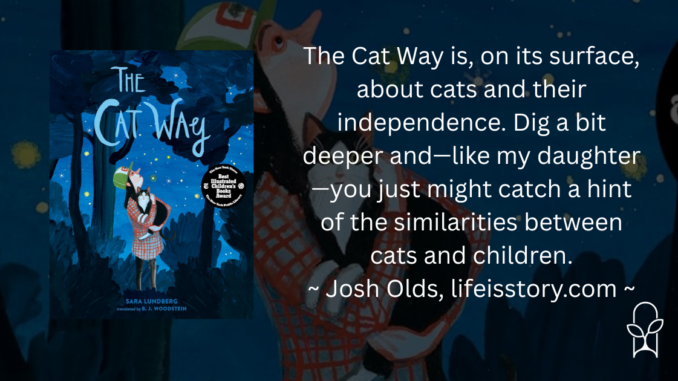
Published by Eerdmans Books for Young Readers on October 8, 2024
Genres: Children's
Buy on Amazon
Goodreads

An unconventional story about navigating differences and learning to be present.
When a cat and her human go for walks, the human always decides where they go and what they do. “But what if it were the other way around?” the cat asks one day. So the next time, the human follows the cat. When the cat is in control, she wants to stop more often, and she wants to chase squirrels and climb up trees. Her human finds all these detours ridiculous. But when you walk at a cat’s pace, you can see the most amazing things.
Painted in richly saturated colors, The Cat Way explores the strange path to compromise and cooperation. Walking together might take some patience—but it can also lead to the most incredible surprises.
My five-year-old daughter loves to pretend to be a cat. For three months last year, she woke up; got dressed; and clipped on a cat tail to her tights, put a toy collar around her neck, and set a cat ear headband on her head. Thirty minutes later, at school, the tail and collar would come off and go into her backpack to await the end of the school day when she could be a cat once again. The Cat Way is, on its surface, about cats and their independence. Dig a bit deeper and—like my daughter—you just might catch a hint of the similarities between cats and children.
The book opens with a cat and their person going for a walk. The person tells the cat where to go and when to go there. But then the cat sees another cat and wants to play. It wants other people to pet it. It wants freedom. It wants agency. It wants to be in charge. The cat’s owner is sad and leaves them. He’s worried that he won’t have his cat anymore, that other people will take her, that she will love them more, that they won’t know how to feed or take care of her. He arrives home and there’s the cat, already there.
The second part of The Cat Way starts off with a walk but the cat is in charge. They go places the human would never. They’re a little more adventurous, being a little more dangerous, and the result—well, I shan’t ruin the artistic surprise at the end—but let me just tell you that Sara Lundberg illustrates the end result in magnificent fashion. (For a bit of a spoiler, just see the beauty that is the front cover.)
I think there’s a lot to be said in this book about childhood and independence. As a parent, my takeaway from this is that when I allow my children space to explore and make their own decisions, they might lead me into beauties and wonders I’d otherwise never see. Freedom and agency to choose allows them space to flourish—and that freedom and agency should not be seen as a threat to me as a parent. It doesn’t mean they love me less. It doesn’t mean they hate my path. It simply means they must grow up and be able to learn and explore their own paths, all while having a safe space called home to which they can return.
